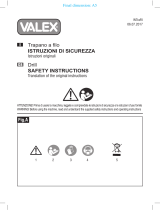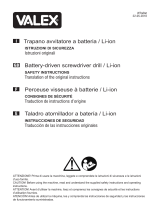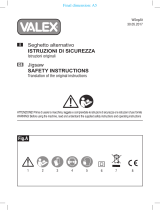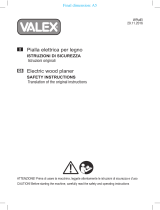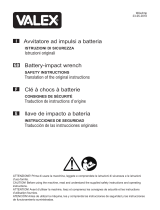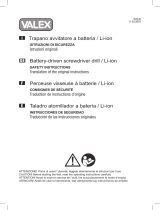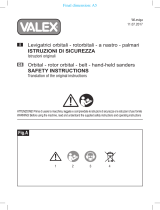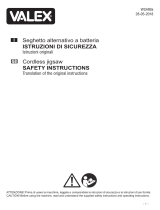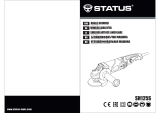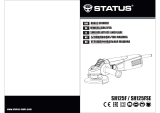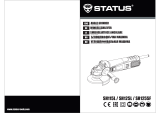La pagina si sta caricando...

WMiscel
29.09.2017
Final dimension: A5
Fig.A
1 42
ATTENZIONE! Prima di usare la macchina, leggete e comprendete le istruzioni di sicurezza e le istruzioni d’uso fornite
WARNING! Before using the machine, read and understand the supplied safety instructions and operating instructions
Miscelatore
ISTRUZIONI DI SICUREZZA
Istruzioni originali
Mixer
SAFETY INSTRUCTIONS
Translation of the original instructions
6 75
3

- 2 -
i
ATTENZIONE! Prima di usare questa mac-
china, leggete tutte le istruzioni di sicurezza e le
istruzioni d’uso fornite. La mancata ottemperan-
za alle avvertenze e alle istruzioni può dare luogo
a scosse elettriche, incendi e/o lesioni serie.
La scrupolosa osservanza di queste avver-
tenze con l’utilizzo dei mezzi di protezione
individuale, minimizzano i rischi di incidente
ma non li eliminano completamente.
Utilizzate l’utensile solo nei modi descritti in
queste istruzioni. Non utilizzatelo per scopi a
cui non è destinato.
Conservare tutte le avvertenze e le istruzioni
per riferimenti futuri.
Il termine “utensile elettrico” delle avvertenze si
riferisce agli utensili elettrici azionati mediante
collegamento alla rete (con cavo) o azionati a
batteria (senza cavo).
SIMBOLOGIA
Osservate con attenzione la simbologia della
fig.A e memorizzate il rispettivo significato. Una
corretta interpretazione dei simboli consente un
uso più sicuro della macchina.
1 Attenzione!
2 Leggete con attenzione tutte le istruzioni
prima dell’uso.
3 Indossare i guanti a protezione delle mani.
4 Indossare gli occhiali a protezione degli occhi
e cuffie antirumore. Indossare la maschera
a protezione delle vie respiratorie.
5 Prima di ogni controllo o manutenzione,
staccate l’alimentazione elettrica scollegan-
do la spina della macchina. In caso di cavo
di alimentazione danneggiato, disinserite la
spina dalla rete di alimentazione prima di
procedere ad un controllo.
6 Pericolo di impigliamento e taglio. Mantenere una
distanza di sicurezza da tutte le parti in movimento.
7 I rifiuti elettrici ed elettronici possono conte-
nere sostanze pericolose per l’ambiente e la
salute umana; non devono pertanto essere
smaltiti con quelli domestici ma mediante
una raccolta separata negli appositi centri di
raccolta o riconsegnati al venditore nel caso
di acquisto di una apparecchiatura nuova
analoga. Lo smaltimento abusivo dei rifiuti
comporta l’applicazione di sanzioni.
AVVERTENZE DI SICUREZZA GENERALE
1) Sicurezza dell’area di lavoro
a) Tenere pulita e ben illuminata l’area di
lavoro. Le aree ingombre e/o poco illuminate
possono provocare incidenti.
b) Non far funzionare utensili elettrici in atmo-
sfere esplosive, ad esempio in presenza di
liquidi, gas, o polveri infiammabili. Gli utensili
elettrici creano scintille che possono provocare
l’accensione di polveri o fumi.
c) Tenere i bambini e i passanti a distanza
durante il funzionamento di un utensile
elettrico. Le distrazioni possono far perdere il
controllo dell’utensile.
d) Mantenete in un luogo sicuro i sacchi di
nylon presenti nell’imballaggio. I sacchi
possono provocare il soffocamento e i bambini
non devono entrarne in possesso.
e) Usate l’utensile in un luogo con un suffi-
ciente ricambio d’aria. L’areazione è neces-
saria per il raffreddamento dell’utensile e per
eliminare impurità nell’aria provocate dalla
lavorazione.
f) Non far funzionare utensili elettrici all’aperto
in presenza di pioggia, nebbia, temporale,
alte e basse temperature, o in ambienti
bagnati o umidi. L’utilizzo in queste condizioni
può provocare la folgorazione.
2) Sicurezza elettrica
a) La spina dell’utensile elettrico deve corri-
spondere alla presa. Mai modificare la spina
in alcun modo. Non utilizzare adattatori con
utensili elettrici dotati di messa a terra (a
massa). Spine non modificate e prese corri-
spondenti riducono il rischio di scossa elettrica.
b) Evitare il contatto del corpo con superfici
messe a terra o a massa quali tubi, radiatori,
cucine e frigoriferi. Se il vostro corpo è a
terra o a massa, il rischio di scossa elettrica
aumenta.
c) Non esporre gli utensili elettrici alla pioggia
e non utilizzarli in luoghi umidi. L’ingresso di
acqua in un utensile elettrico aumenta il rischio
di scossa elettrica.
d) Non usurare il cavo. Non utilizzare mai il cavo
per trasportare, tirare o scollegare dalla presa
di rete l’utensile elettrico. Tenere il cavo distante
da calore, olio, bordi affilati o parti in movimen-
to. Cavi danneggiati o attorcigliati aumentano il
rischio di scossa elettrica.
e) Quando si aziona un utensile elettrico all’e-
sterno, usare un cavo di prolunga adeguato
per l’uso in esterni. L’uso di un cavo adeguato

- 3 -
riduce il rischio di scossa elettrica.
f) Utilizzare un’alimentazione elettrica protetta
da un interruttore differenziale (RCD). L’utiliz-
zo di un interruttore differenziale (RCD) riduce
il rischio di scossa elettrica.
g) L’alimentazione elettrica deve corrispon-
dere a quella indicata sull’utensile elettrico.
Una alimentazione elettrica non idonea genera
malfunzionamenti ed incidenti.
h) Verificate periodicamente il cavo di alimen-
tazione elettrica. Non schiacciate o calpe-
state il cavo di alimentazione elettrica. Un
cavo danneggiato è fonte di scosse elettriche.
Se danneggiato estraete la spina e non usate
l’utensile elettrico.
i) In caso di dubbio in campo elettrico affida-
tevi ad tecnico specializzato di comprovata
esperienza. L’utilizzo dell’elettricità in modo
non sicuro è molto pericoloso per la vostra ed
altrui incolumità.
3) Sicurezza personale
a) Non distrarsi mai, controllare quello che si
sta facendo e usare il buon senso quando si
azionano utensili elettrici. Non azionare l’u-
tensile quando si è stanchi o sotto l’influsso
di droghe, alcol o medicinali. Un momento di
disattenzione durante l’azionamento di utensili
elettrici può dare luogo a serie lesioni personali.
b) Usare un’apparecchiatura di protezione per-
sonale. Indossare sempre protezioni per gli
occhi. Le apparecchiature di protezione quali
maschere antipolvere, abbigliamento robusto,
calzature di sicurezza antiscivolo, casco di
sicurezza, guanti di sicurezza e protezioni per
l’udito riducono la possibilità di subire lesioni
personali.
c) Prevenire le accensioni accidentali. As-
sicurarsi che l’interruttore sia in posizione
di spento prima di collegare l’utensile alla
rete elettrica e/o ai gruppi di batterie, prima
di prenderlo o di trasportarlo. Trasportare
utensili elettrici con il dito sull’interruttore o
collegarli in rete con l’interruttore in posizione
di accensione può provocare incidenti.
d) Rimuovere qualsiasi chiave di regolazione
prima di accendere l’utensile elettrico. Una
chiave lasciata attaccata ad una parte rotante
dell’utensile elettrico può provocare lesioni
personali.
e) Non sbilanciarsi. Mantenere sempre la
posizione e l’equilibrio appropriati. Questo
permette di controllare meglio l’utensile elet-
trico in situazioni impreviste.
f) Vestirsi in modo appropriato. Non indos-
sare vestiti larghi o gioielli. Tenere capelli,
indumenti e guanti distanti dalle parti in mo-
vimento. Vestiti larghi, gioielli o capelli lunghi
possono impigliarsi nelle parti in movimento.
g) Se sono previsti dispositivi da collegare
ad impianti per l’estrazione e la raccolta di
polvere, accertarsi che siano collegati e usati
in maniera appropriata. L’uso di questi dispo-
sitivi può ridurre i rischi correlati alla polvere.
h) L’utilizzatore è responsabile verso terzi di
eventuali incidenti o danni a persone o cose.
Un uso improprio provoca incidenti e danni.
i) E’ vietato l’utilizzo a piedi nudi o con piedi
e/o mani bagnati/e. L’utilizzo in queste condi-
zioni può provocare la folgorazione.
l) La lavorazione di materiali nocivi alla salute
deve avvenire nel rispetto delle leggi vigenti.
Alcuni tipi di polveri e materiali come metalli,
legni, vernici ecc. sono molto dannosi alla
salute. Salvaguardare la propria ed altrui salute
adottando protezioni ed accorgimenti idonei.
m) Non avvicinarsi alle feritoie di espulsione
dell’aria di raffreddamento. L’aria generata
può contenere residui di lavorazione, piccole
parti dannose per le vie respiratorie e per gli
occhi.
n) Non coprire e non infilare cose sulle feritoie
di raffreddamento. La mancata ventilazione
dell’utensile elettrico può generare un incen-
dio. Accedere a parti interne può danneggiare
l’utensile e provocare la folgorazione.
o) Non utilizzare l’utensile elettrico se le
protezioni (schermi, pannelli, sportelli ecc.)
sono aperti, danneggiati o mancanti. Le
protezioni correttamente installate salvaguar-
dano la vostra salute e consentono un utilizzo
in sicurezza.
4) Uso e manutenzione degli utensili elettrici
a) Non forzare l’utensile elettrico. Usare l’u-
tensile adatto per l’operazione da eseguire.
L’utensile elettrico appropriato permette di
eseguire il lavoro con maggiore efficienza e
sicurezza senza essere costretti a superare i
parametri d’uso previsti.
b) Non usare l’utensile elettrico se l’inter-
ruttore di accensione e spegnimento non
si aziona correttamente. Qualsiasi utensile
elettrico che non può essere controllato con
l’interruttore è pericoloso e deve essere sot-
toposto a riparazioni.
c) Scollegare la spina dalla rete di alimenta-
zione e/o il gruppo di batterie dall’utensile

- 4 -
elettrico prima di effettuare qualsiasi rego-
lazione, cambiare accessori o riporre gli
utensili elettrici. Tali misure di sicurezza pre-
ventiva riducono il rischio di avvio accidentale
dell’utensile elettrico.
d) Riporre utensili elettrici inutilizzati fuori
della portata dei bambini e non permetterne
l’uso a persone inesperte dell’utensile o che
non conoscano queste istruzioni. Gli utensili
elettrici sono pericolosi se utilizzati da persone
inesperte.
e) Effettuare la manutenzione necessaria
sugli utensili elettrici. Verificare il possibile
errato allineamento o bloccaggio delle parti
in movimento, la rottura delle parti e qual-
siasi altra condizione che possa influenzare
il funzionamento degli utensili elettrici. Se è
danneggiato, far riparare l’utensile elettrico
prima di utilizzarlo. Numerosi incidenti sono
provocati proprio dal cattivo stato di manuten-
zione degli utensili elettrici.
f) Mantenere puliti e affilati gli strumenti di ta-
glio (se presenti). Strumenti di taglio in buone
condizioni di manutenzione e con bordi di taglio
affilati sono meno suscettibili di bloccarsi e
sono più facili da controllare.
g) Usare l’utensile elettrico, gli accessori
ecc., in conformità con queste istruzioni,
tenendo conto delle condizioni di lavorazione
e dell’operazione da eseguire. L’uso dell’uten-
sile elettrico per operazioni diverse da quelle
previste può dare luogo a situazioni pericolose.
h) Sostenere l’utensile con le impugnature
isolate, quando si effettua un’operazione
nel corso della quale l’organo di lavoro può
venire in contatto con dei cavi nascosti. Gli
organi di lavoro venendo in contatto con un
conduttore “in tensione” possono mettere
“in tensione” le parti metalliche dell’utensile
elettrico e provocare una scossa elettrica
(elettrocuzione) all’operatore.
i) Mantenete una distanza di sicurezza dalle
parti in movimento. Toccare parti in movimen-
to provoca lesioni serie.
l) Non modificate l’utensile elettrico. Togliere,
sostituire o aggiungere componenti non previsti
dalle istruzioni, è vietato ed annulla la garanzia.
m) Non abbandonare l’utensile elettrico in fun-
zione. Spegnetelo prima di lasciarlo incustodito
per evitare possibili incidenti.
n) L’utensile elettrico non deve mai venire a
contatto con l’acqua o altri liquidi. L’utilizzo
in queste condizioni può provocare la folgo-
razione.
5) Assistenza
a) Fare effettuare le operazioni di manu-
tenzione sugli utensili elettrici da parte di
personale tecnico qualificato che utilizza
soltanto ricambi originali. Questo permetterà
di mantenere la sicurezza dell’utensile elettrico.
b) Non tentare di riparare l’utensile elettrico
o di accedere ad organi interni. Interventi
effettuati da personale non qualificato e non
autorizzato dalla Ditta costruttrice può generare
seri pericoli ed annulla la garanzia.
c) Richiedete solo ricambi originali. L’utilizzo
di ricambi non originali può compromettere la
sicurezza dell’utensile elettrico.

- 5 -
AVVERTENZE DI SICUREZZA DEL MISCELATORE
1) Sicurezza
a) Indossare delle protezioni per le orecchie
quando si usa l’utensile. L’esposizione ai
rumori può provocare una perdita dell’udito.
b) Utilizzare la/le impugnatura/e fornita con
l’utensile. La perdita di controllo può provo-
care delle ferite.
c) Mantenete una distanza di sicurezza da tutte
le parti in movimento.
d) Prima di inserire o togliere la frusta dal
mandrino, staccare la spina. Ogni manuten-
zione deve avvenire in sicurezza per evitare
incidenti provocati da un avvio improvviso.
e) Se l’utensile si blocca durante l’utilizzo,
spegnerlo subito. Non forzate con operazioni
gravose per l’utensile.
f) Mantenete ben saldo l’utensile. Gli sforzi
provocati dalla lavorazione provocano solle-
citazioni che è necessario contrastare con la
vostra forza.
g) Attendete l’arresto completo dell’utensile
elettrico prima di posarlo. Le parti in movi-
mento possono provocarne la caduta.
h) Attenzione! Avviare solo se la frusta è
all’interno del contenitore e immersa nel
materiale da miscelare.
i) Attenzione! Durante l’uso non inserire la
mano o i piedi nel contenitore. Manovrate
con prudenza il miscelatore mantenendolo
lontano dalle gambe, dal vestiario e dal cavo
di alimentazione elettrica.
AVVERTENZE DI SICUREZZA PER LA
RUMOROSITA’ E PER LE VIBRAZIONI
Il livello di rumorosità e di vibrazioni riportate
nel foglio allegato, sono valori medi di utilizzo
dell’elettroutensile. L’impiego di elementi di
miscelazione diversi, materiali diversi, assenza
di manutenzione all’elettroutensile influiscono
in modo significativo nelle emissioni sonore
e nelle vibrazioni. Di conseguenza adottate
tutte le misure preventive in modo da eliminare
possibili danni dovuti ad un rumore elevato e
alle sollecitazioni da vibrazioni; indossate cuffie
antirumore, guanti antivibrazioni, effettuate
delle pause durante la lavorazione, mantenete
efficiente l’elettroutensile e gli accessori.
RISCHI RESIDUI
Queste illustrazioni mostrano i rischi principali
nell’uso della macchina. Leggete attentamente
il libretto istruzioni della macchina.
Rumore elevato
generato durante
l’uso. Indossate
cuffie a protezione
dell’udito.
Rischio di impi-
gliamento o di
taglio. Mantenere
una distanza di
sicurezza da tutte
le parti in movi-
mento.
Rischio di scossa
elettrica con peri-
colo di morte. Non
toccate le parti in
tensione elettri-
ca e mantenete
una distanza di
sicurezza. Prima
di ogni manuten-
zione scollegate la
spina dalla presa
di alimentazione.

- 6 -
g
IMPORTANT! Before using this product
read all the enclosed safety instructions and
instructions for use. Failure to comply with the
warnings and instructions may cause electric
shock, fire and/or serious injuries.
Strict observance of these warnings with
the use of personal protective equipment
minimizes risks of accidents but does not
completely rule them out.
Only use the tool as instructed in this manual.
Do not use it for purposes for which it was not
intended.
Store all warnings and instructions for future
reference.
The term “ power tool “ of the warnings refers to
your power tools operated by connecting to the
network (wired) or battery operated (cordless).
SYMBOLS
Carefully observe the symbols in fig.A and
memorise their respective meanings. Correct
interpretation of the symbols allows a safer use
of the machine.
1 Warning!
2 Carefully read all instructions before use.
3 Wear protective gloves.
4 Wear safety goggles to protect your eyes,
and safety earmuffs. Wear a dust mask to
protect your respiratory tracts.
5 Before any controls or maintenance, always
disconnect the machine plug from the power
supply. Should the power supply cord be
damaged, unplug it from the power supply
socket before inspecting it.
6 Risk of pinching and cutting. Maintain a safe
distance from all moving parties.
7 Electric and electronic waste may contain
potentially hazardous substances for the
environment and human health: they should
not, therefore, be disposed of along with
domestic waste but be taken to specific
centres for differentiated refuse collection
or returned to the vendor in the event of
purchasing a new, identical appliance. The
illegal disposal of waste will result in sanctions.
GENERAL SAFETY
1) Work Area Safety
a) Keep clean and well lit work area. The
areas cluttered and / or poorly lit can cause
accidents.
b) Do not operate power tools in explosive
atmospheres, such as in the presence of
liquids, gases or inflammable dusts. Power
tools create sparks which may ignite dust or
fumes.
c) Keep children and bystanders away while
operating a power tool. Distractions can cause
you to lose control of the tool.
d) Keep in a safe place the nylon bags in the
package. The bags can cause suffocation and
children should not gain possession.
e) Use the tool in a location with adequate
ventilation. The ventilation is required for
cooling the tool and to remove impurities in
the air caused by the machining .
f) Do not operate power tools outdoors in rain,
fog, storm, high and low temperatures or in
wet or damp environments. The use of these
terms may result in electric shock.
2) Electrical safety
a) Power tool cabinet must match the outlet.
Never modify the plug in any way. Do not use
an adapter with power tools equipped with
a grounded (earthed). Unmodified plugs and
matching sockets reduce the risk of electric
shock.
b) Avoid body contact with earthed or
grounded surfaces such as pipes, radiators,
cookers and refrigerators. If your body is on
the ground or grounded, the risk of electric
shock is increased.
c) Do not expose power tools to rain or use in
damp locations. The entry of water into a po-
wer tool will increase the risk of electric shock.
d) Do not wear out the cable. Never use the
cord for carrying, pulling or unplugging from
the wall outlet power tool. Keep the cord
away from heat, oil, sharp edges or moving
parts. Damaged or entangled cords increase
the risk of electric shock.
e) When operating a power tool outdoors, use
an extension cord suitable for outdoor use.
The use of an appropriate cable reduces the
risk of electric shock.
f) Use a power supply protected by a residual
current circuit breaker (RCD). The use of a
residual current circuit breaker (RCD) reduces
the risk of electric shock.

- 7 -
g) The power supply must match the one spe-
cified on the power tool. An unsuitable power
supply generates malfunctions and accidents.
h) Check periodically the electrical supply
cable. Not crushed or trampled the power
supply cable. A damaged power cord is a
source of electric shock. If damaged pull the
plug and do not use the power tool .
i) In case of doubt in the electric field, rely
on technician with proven experience. The
use of electricity in an unsafe manner is very
dangerous for your and others’ safety.
3) Personal Safety
a) Stay alert , check what you are doing and
use common sense when operating a power
tool. Do not operate the tool when you are
tired or under the influence of drugs, alcohol
or medication. A moment of inattention while
operating power tools may result in serious
personal injury.
b) Use of personal protective equipment.
Always wear eye protection. Protective
equipment such as dust masks, clothing
sturdy, non-slip safety shoes, safety helmet,
safety gloves and hearing protection reduce
the chance of injuring yourself.
c) Prevent accidental starting. Make sure that
the switch is in the off position before con-
necting the tool to the mains and/or battery
packs, picking up or carry it. Carrying power
tools with your finger on the switch or connect
them in a network with the switch in the on
position may cause an accident .
d) Remove any adjusting key before turning
the power tool. A key left attached to a rotating
part of the power tool may result in personal
injury.
e) Do not overreach. Always keep proper foo-
ting and balance. This allows better control of
the power tool in unexpected situations.
f) Dress appropriately. Do not wear loose
clothing or jewelry. Keep your hair, clothing
and gloves away from moving parts. Loose
clothes, jewelery or long hair can be caught
in moving parts.
g) If devices are provided for connection to
equipment for extraction and collection
of dust, ensure these are connected and
properly used. The use of these devices can
reduce dust related hazards.
h) The user is responsible to third parties
for any accident or damage to persons or
property. Improper use will cause accidents
and damage.
i) It is forbidden to use with bare feet or with
wet feet/hands. The use in these conditions
may result in electric shock.
l) The processing of materials hazardous to
health must be in compliance with applicable
laws. Some types of powders and materials
such as metals, wood , paint , etc. are very
harmful to health. Safeguard their own and
others’ health protections and adopting suitable
measures.
m) Do not touch any openings of exhaust air
cooling. The air generated can contain residues
of processing, small parts harmful to the re-
spiratory tract and eyes.
n) Do not cover or stick things on the cooling
holes. The lack of ventilation of the power
tool may cause fire. Access to internal parts
can cause damage to the tool and cause
electrocution.
o) Do not use the power tool if the protections
(screens, panels, doors, etc.) are opened,
damaged or missing. The guards properly
installed safeguard your health and provide
safe operation.
4) Use and maintenance of power tools
a) Do not force the power tool. Use the right
tool for the task to be performed. The ap-
propriate power tool allows you to perform
the work with greater efficiency and safety
without having to exceed the parameters of
use envisaged.
b) Do not use the power tool if the switch does
not turn on and off properly. Any power tool
that can not be controlled with the switch is
dangerous and must be subjected to repairs.
c) Disconnect the plug from the power supply
and/or the battery pack from the power tool
before making any adjustments, changing
accessories, or storing power tools. Such
preventive safety measures reduce the risk of
starting the power tool accidentally.
d) Store unused power tools out of the reach
of children and do not allow their use by
unskilled persons who do not know the tool or
these instructions. Power tools are dangerous
in the hands of untrained users.
e) Perform the necessary maintenance on po-
wer tools. Check the possible misalignment
or blockage of moving parts, breakage of
parts and any other condition that may affect
the operation of power tools. If damaged,
have the power tool repaired before use.
Many accidents are caused just by the poor
state of maintenance of power tools .

- 8 -
f) Keep tools sharp and clean cut (if any).
Cutting tools in a well maintained condition
and with sharp cutting edges are less likely to
get stuck and are easier to control.
g) Use the power tool, accessories... in
accordance with these instructions, taking
into account the working conditions and the
operation to be performed. The use of the
power tool for operations different from those
intended could result in a hazardous situation.
h ) Support tool with insulated handles when
you make a transaction during which the wor-
king body can come in contact with hidden
wiring. The bodies of work coming in contact
with a “supply” conductor can put “live“ the
metal parts of the power tool and cause an
electric shock (electrocution) operator.
i) Maintain a safe distance from moving parts.
Touch moving parts causing serious injuries.
l) Do not modify the power tool. Remove,
replace or add components not covered by
the instructions is prohibited and will void the
warranty.
m) Do not leave the power tool on. Turn it off
before leaving it unattended to prevent possible
accidents.
n) The power tool must never come in contact
with water or other liquids. The use of these
terms may result in electric shock.
5) Support
a) Making perform maintenance on power
tools by a qualified technician using only
original spare parts. This will help to maintain
the safety of the power tool.
b) Do not groped to repair the power tool or
access to internal organs. Interventions car-
ried out by unqualified and unauthorized by the
Manufacturer can create serious hazards and
void the warranty.
c) Request only original spare parts. The use of
unauthorized parts can compromise the safety
of the power tool.
SAFETY OF MIXER
1) Security
a ) Wear ear protectors when using the tool.
Exposure to noise can cause hearing loss.
b) Use the handle/s supplied with the tool. Loss
of control can result in injury.
c) Maintain a safe distance from all moving
parts.
d) Before inserting or removing the whip from
the chuck, pull the plug. Any maintenance
must be in place to prevent accidents caused
by a sudden start.
e) If the tool crashes during use, turn it off
immediately. Do not force with heavy opera-
tions for the tool.
f) Hold the tool firmly. Efforts cause stress
caused by work that is necessary to fight with
your strength .
g ) Wait for the complete shutdown of the
power tool before placing it. Moving parts
can cause it to fall.
h) Warning! Start only if the whip is inside
the container and immersed in the material
to be mixed.
i) Warning! Do not place your hand or feet in
the container during use. Carefully operate
the mixer by keeping it away from the legs,
clothing, and power supply cord.
SAFETY INSTRUCTIONS FOR THE NOISE
AND VIBRATIONS
The level of noise and vibration levels shown in
the attached sheet are average values of use of
the tool. The use of different mixing elements,
different materials, the absence of electric tool
maintenance have a significant influence in the
noise emissions and vibrations. Consequently
taken all preventive measures to eliminate pos-
sible damage due to high noise and stress from
vibration, wear ear defenders, anti-vibration glo-
ves, made of breaks during the work, maintain
efficient power tools and accessories.

- 9 -
RESIDUAL RISKS
These illustrations show the main risks in the
use of the machine. Carefully read the instruction
manual of the machine.
High noise gene-
rated during the
use. Wear ear pro-
tection of hearing.
Risk of pinching or
cutting. Maintain a
safe distance from
all moving parts.
Risk of electric
shock and danger
of death. Do not
touch live electri-
cal parts and keep
a safe distance.
Before any main-
tenance discon-
nect the plug from
the power outlet.

- 10 -

- 11 -

1/12
